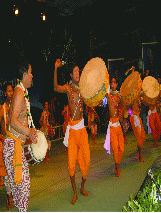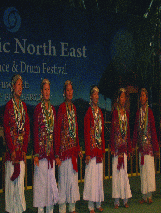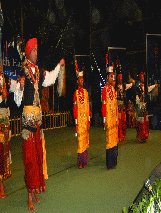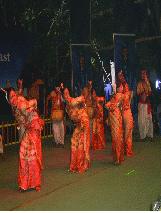Archives
Rhythmic North East
Miss V. Sekhose the Director General of Doordarshan, while welcoming the invited guests informed that  Doordarshan has completed 50 years of service to the people of India and ithat the time has come to look back and review its all round activities in the region. She further said that the Northeastern region presents different types of challenges in spite of which there is no lack of commitment and dedication to serve the community. She felt that the festival ‘Rhythmic North East’ will spread the message of togetherness, harmony and peace in a very appropriate manner.
Doordarshan has completed 50 years of service to the people of India and ithat the time has come to look back and review its all round activities in the region. She further said that the Northeastern region presents different types of challenges in spite of which there is no lack of commitment and dedication to serve the community. She felt that the festival ‘Rhythmic North East’ will spread the message of togetherness, harmony and peace in a very appropriate manner.
Mr. B. S. Lali, CEO, Doordarshan, was the Guest of Honour and said that the North East has always been known for its wealth of folk tradition. Doordarshan and All India radio is performing the task of preserving the folk dance and culture and has already started the work of digitization so that the same can be preserved.
The idea of the festival is to bring different folk dances and drum skills at one place, as the North East is a land of diversity. “Our objective is to integrate this diversity with the rest of India,” said Mr. B. S. Lali. The North East has a special place in Doordarshan and we have a special package for the region.
 Katang Katang Dance of Arunchal Pradesh:
Katang Katang Dance of Arunchal Pradesh:This folk dance is performed during occasions like marriages, the construction of a house, post harvest and for welcoming and entertaining guests.
Dhon Dhulok, Dance of Manipur:
Another highly acclaimed show of drummers is the Dhon Dhulok Cholom. The agility and skill on the part of the players while performing the Dhon Dhulok Cholom is remarkable.
Zeliang Folk Dance of Nagaland:
Zelang dance is a folk dance which is performed by both men & women. In this dance there is nothing like individual performance. It is performed in a circle.
Shad Suk Mynsiem Dance of Meghalaya:
The Khasis offer this dance to pay their obeisance to God the Almighty for His blessings for the year that had gone by and the blessings for the coming year.
Kay (Chyabrung) of Sikkim:
This is a stately and solemn dance with synchronized stepping of feet generally performed by male dancers or drummers numbering two or more.

Cheraw Dance of Mizoram:
It is believed that this dance had already existed way back in the 1st century A.D., while the Mizos migrated into the Chin Hills in the 13th century A.D. and eventually to present Mizoram.
 Composite Bihu Dance of Assam:
Composite Bihu Dance of Assam:
Bihu dance is part of the celebration of the Assamese New Year. The dance has undergone certain changes under the stress of civilization and the process of bringing it to the stage from the open fields.
Bardoi Sikhla (Bodo) dance of Assam:
This dance represents the advent of the New Year, in the month of April, (Chaitra and Baisakh). In Assam, the ‘Bardoisila’ is derived from the Bodo word, ‘Bardoi Sikhla’ – a young girl composed of ‘Bar and Bi’. Bar means wind and Dai means water.
Wangala Dance of Garo Hills (Meghalaya):
Wangala is a harvest festival and the biggest festival of the Garos of Meghalaya performed in connection with the Jhum Cultivation.
Bau Nach of Barak Valley (Assam):
Dance had always been an integral part of the socio – cultural life of the Bengalis in the Barak valley in South Assam.
Sarlamkai / Solakia Dance of Mizoram:
This is an impressive dance originating from the Pawi and Mara communities in the southern part of Mizoram. This dance is known as ‘Sarlamkai’ by the Pawi and ‘Solakis’ by the Mara.
Gariya Dance of Tripura:
It is an exclusive form of religious celebration which belongs to the Tripuri Community of Tripura. This dance form is performed as a symbol of the high yield of crops.
Lai haraoba Dance of Manipur:
Lai Haroba dance mirrors the pre-Vaishanvite culture of Manipur. It is celebrated widely sometime during March-April before the village temple of the ‘Umang - Lai’, the ancestral God of the Meitei of the valley of Manipur.
Myoya Ayo Dance of Arunachal Pradesh:
The Aka tribe inhabits the East and West Kameng districts of Arunachal Pradesh. ‘Myoya Ayo, Sarok Ayo’ is a very popular dance form of the people belonging to the Aka tribe.

